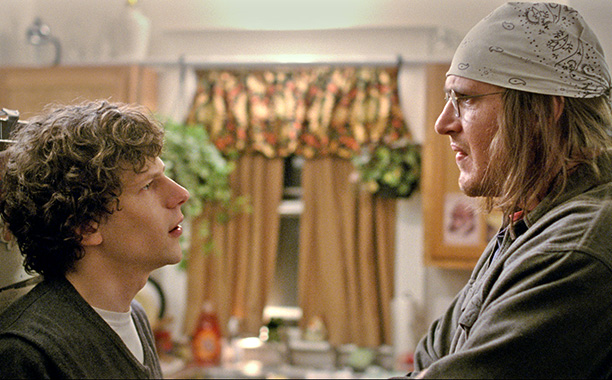By providing your information, you agree to our Terms of Use and our Privacy Policy. We use vendors that may also process your information to help provide our services. This site is protected by reCAPTCHA Enterprise and the Google Privacy Policy and Terms of Service apply.
David Foster Wallace Cheat Sheet: 7 Things You Need to Know Before Seeing ‘The End of the Tour’

 READ MORE: 7 Must-See Movies About Writers
READ MORE: 7 Must-See Movies About Writers
As far as contemporary American literary heroes go, you’d be hard-pressed to find a scholar who wouldn’t put David Foster Wallace at the top of the canon. Wallace is widely heralded as one of the most influential writers of the last hundred years. His fiction and nonfiction pushed postmodern boundaries. He dealt in irony and contradiction to expose the intestines of American psyche, from life post-9/11 to our addiction to television to the tedium of luxury cruise lines. His writing style, also contradictory and ironic, follows suit: It’s both manic and obsessed with rationale; pessimistic and optimistic; esoteric and familiar. Only Wallace could render the arcane details of a lobster festival riveting. Only Wallace could cajole readers into enduring nearly 500 footnotes in a thousand-page dystopian tome. Only Wallace could make you feel at once so deeply uncomfortable and immensely hopeful about being human.
This week, A24 releases James Ponsoldt‘s “The End of the Tour.” It’s the first time moviegoing audiences will see a representation of Wallace onscreen. The film isn’t a biopic, so it shies from providing much contextual information about the writer. Still, “The End of the Tour” is a much richer viewing experience if one is familiar with Wallace and his oeuvre. Based on the ground covered in the film, we’ve assembled a list of seven important facts, essays, stories and considerations about Wallace that will enhance the viewing experience for those unfamiliar with the late author’s life and work.
1. Must-read fiction:
“Infinite Jest” is by far both Wallace’s most famous and most obscenely dense novel. Devoted fans swear by its merits, while some others claim it’s a waste of time. Only one thing is certain: If you plan on embarking upon “Infinite Jest,” prepare to give over at least a month of your life. Wallace’s other notable works of fiction are “The Depressed Person,” in which he vivisects the emotional landscape of depression, and “Good Old Neon,” in which the main character expresses Wallace’s own deepest fear of being a fraud.
2. Must-read nonfiction:
Wallace wrote “Consider the Lobster” for Gourmet after being assigned to cover the Maine Lobster Festival, but his concerns ultimately turned from culinary to ethical. In “A Supposedly Fun Thing I’ll Never Do Again,” Wallace argues that cruise ships are lethal. In “Up, Simba,” Wallace takes on politics to write about John McCain’s 2000 presidential campaign. Wallace’s essay “The View from the Midwest” confronts America in its most crippling state, post-9/11.
3. He had issues with romantic insecurity.
Despite the fact that he regularly slept around, Wallace harbored incapacitating insecurities when it came to romance. In fact, his turbulent romance with memoirist Mary Karr, who he once tried to push out of a moving vehicle, reportedly spurred “Infinite Jest.” Similarly, after being rejected by “Prozac Nation” author Elizabeth Wurtzel, Wallace wrote “The Depressed Person” and based the titular character — an insufferably unpleasant person — on her. Wallace also routinely became jealous and competitive with friends’ girlfriends, causing myriad interpersonal problems.
Read More: James Ponsoldt on Why ‘The End of the Tour’ Is Not a David Foster Wallace Biopic

4. He was from the Midwest.
Midwest-bred Wallace is known for incorporating elements of Americana into all facets of his writing. “Derivative Sport in Tornado Alley” is a clear window into his upbringing and the influence it had on his perspective.
5. He was uncomfortable with fame and public image.
Wallace was notoriously averse to interviews and had difficulty reconciling his personal reputation with his public persona. Much of “The End of the Tour” shows Wallace grappling with the self and the image of the self. Despite his fears, however, Wallace gave one of the most memorable graduation speeches in recent history at Kenyon College, in which he said, “The really important kind of freedom involves attention and awareness and discipline, and being able truly to care about other people and to sacrifice for them over and over in myriad petty, unsexy ways every day.”
6. He suffered from debilitating depression and addiction.
“Wallace understood from the beginning that his fall from grace was a literary opportunity,” wrote D.T. Max in his memoir “Every Love Story is a Ghost Story: The Life of David Foster Wallace.” He moved in and out of psychiatric hospitals and addiction treatment centers battling depression, alcoholism and various drug addictions. Eventually, Wallace opted for electroconvulsive-shock therapy following multiple suicide attempts and failed efforts to mitigate his condition with medication.
7. He committed suicide in 2008. He was 46.
“Everything had been tried; he just couldn’t stand it anymore,” said James Wallace, David’s father, in The New York Times’ heartbreaking obituary.
Read More: Jason Segel on Why It Was Time to Redefine His Career in ‘The End of the Tour’
By providing your information, you agree to our Terms of Use and our Privacy Policy. We use vendors that may also process your information to help provide our services. This site is protected by reCAPTCHA Enterprise and the Google Privacy Policy and Terms of Service apply.

















